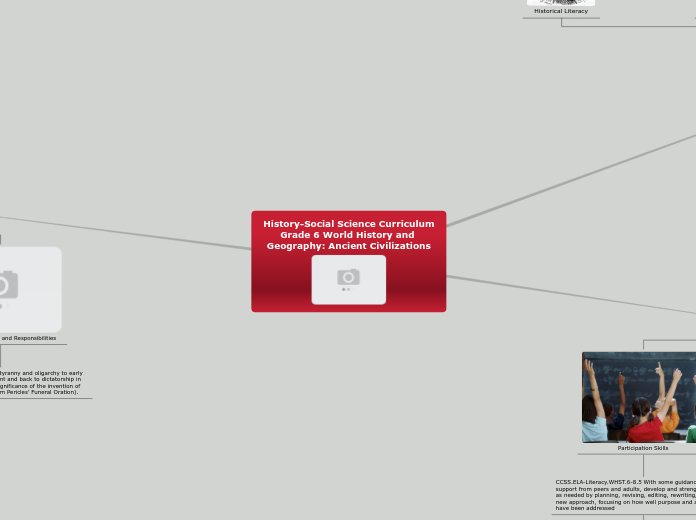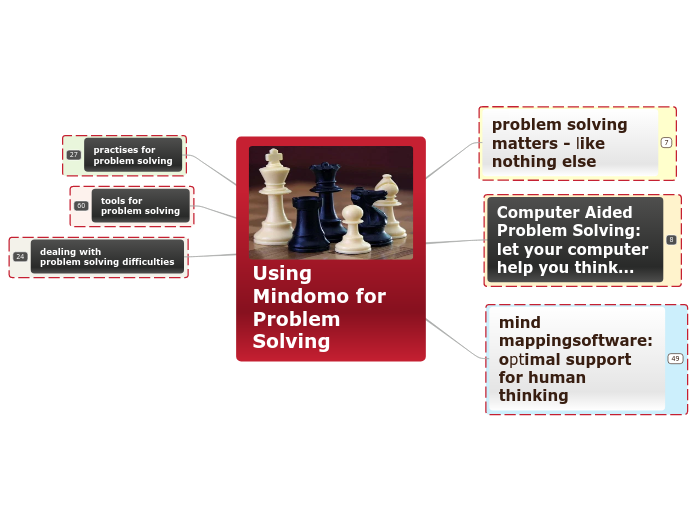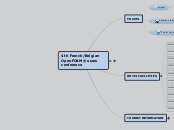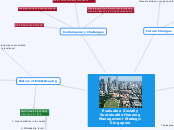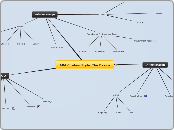History-Social Science Curriculum
Grade 6 World History and Geography: Ancient Civilizations
Goal of Democratic Understanding and Civic Values
Civic Values, Rights, and Responsibilities
6.4.2 Trace the transition from tyranny and oligarchy to early democratic forms of govern ment and back to dictatorship in ancient Greece, including the significance of the invention of the idea of citizenship (e.g., from Pericles’ Funeral Oration).
Constitutional Heritage
6.4.2 Trace the transition from tyranny and oligarchy to early democratic forms of govern ment and back to dictatorship in ancient Greece, including the significance of the invention of the idea of citizenship (e.g., from Pericles’ Funeral Oration).
6.7.2 Describe the government of the Roman Republic and its significance (e.g., written constitution and tripartite government, checks and balances, civic duty).
National Identity
No relevant standards
Goal of Skills Attainment and Social Participation
Basic Study Skills
CCSS.ELA-Literacy.WHST.6-8.4 Produce clear and coherent writing in which the development, organization, and style are appropriate to task, purpose, and audience.
CCSS.ELA-Literacy.WHST.6-8.8 Draw evidence from informational texts to support analysis reflection, and research.
CCSS.ELA-Literacy.RH.6-8.7 Integrate visual information (e.g., in charts, graphs, photographs, videos, or maps) with other information in print and digital texts.
Critical Thinking Skills
CCSS.ELA-Literacy.WHST.6-8.1b Support claim(s) with logical reasoning and relevant, accurate data and evidence that demonstrate an understanding of the topic or text, using credible sources.
CCSS.ELA-Literacy.WHST.6-8.9 Draw evidence from informational texts to support analysis reflection, and research.
CCSS.ELA-Literacy.RH.6-8.1 Cite specific textual evidence to support analysis of primary and secondary sources.
Participation Skills
CCSS.ELA-Literacy.WHST.6-8.5 With some guidance and support from peers and adults, develop and strengthen writing as needed by planning, revising, editing, rewriting, or trying a new approach, focusing on how well purpose and audience have been addressed
CCSS.ELA-Literacy.WHST.6-8.7 Conduct short research projects to answer a question (including a self-generated question), drawing on several sources and generating additional related, focused questions that allow for multiple avenues of exploration.
CCSS.ELA-Literacy.RH.6-8.2 Determine the central ideas or information of a primary or secondary source; provide an accurate summary of the source distinct from prior knowledge or opinions.
Goal of Knowledge and Cultural Understanding
Socciopolitical Literacy
6.2.4 Know the significance of Hammurabi’s Code.
6.4.3 State the key differences between Athenian, or direct, democracy and representative democracy.
6.5.4 Outline the social structure of the caste system.
Which statement about the Hindu caste system in India is accurate?
A. Different castes shared the same rules for governing their behavior
B. Foreigners were treated as memebers of the lower caste
C. Castes were encouraged to interact with one another
D. People were required to stay in the same caste to which they were born
Economic Literacy
6.2.2 Trace the development of agricultural techniques that permitted the production of economic surplus and the emergence of cities as centers of culture and power.
6.6.7 Cite the significance of the trans-Eurasian “silk roads” in the period of the Han Dy nasty and Roman Empire and their locations.
In the 700s A.D., Arabian merchants played an important role in
A. Spreading new technology among Asia, Africa, and Europe
B. Converting large numbers of Western Europeans to Islam
C. Uniting most of ASia and Europe under a single religion
D. Stopping the invasions of nomadic people from Central Asia
Geographic Literacy
6.1.2 Identify the locations of human communities that populated the major regions of the world and describe how humans adapted to a variety of environments.
6.4.1 Discuss the connections between geography and the development of city-states in the region of the Aegean Sea, including patterns of trade and commerce among Greek city-states and within the wider Mediterranean region.
6.5.1 Locate and describe the major river system and discuss the physical setting that sup ported the rise of this civilization.
Greece’s mountainous terrain and its series of small islands influenced the ancient Greeks to develop
A. A political system based on independent city-states
B. A culture that was uniform throughout its vast empire
C. An economic system based on mining precious metals
D. A society completely isolated from other civilizations
Cultural Literacy
6.4.4 Explain the significance of Greek mythology to the everyday life of people in the region and how Greek literature continues to permeate our literature and language today, drawing from Greek mythology and epics, such as Homer’s Iliad and Odyssey, and from Aesop’s Fables.
6.4.7 Trace the rise of Alexander the Great and the spread of Greek culture eastward and into Egypt.
6.7.8 Discuss the legacies of Roman art and architecture, technology and science, literature, language, and law.
The legacy of ancient Greek myths and epics, such as the Iliad, continues to provide people with
A. Accurate descriptions of historical events
B. Heoric figures and great adventures
C. Real life stories about everyday people
D. Objective studies of ancient civilizations
Ethical Literacy
6.3.1 Describe the origins and significance of Judaism as the first monotheistic religion based on the concept of one God who sets down moral laws for humanity.
6.3.5 Discuss how Judaism survived and developed despite the continuing dispersion of much of the Jewish population from Jerusalem and the rest of Israel after the destruc tion of the second Temple in A.D. 70.
6.6.8 Describe the diffusion of Buddhism northward to China during the Han Dynasty.
Jewish scrpture says that God's laws were delivered to the ancient Hebrews by
A. Abraham
B. Solomon
C. Moses
D. David
Historical Literacy
6.3.2Identify the sources of the ethical teachings and central beliefs of Judaism (the Hebrew Bible, the Commentaries): belief in God, observance of law, practice of the concepts of righteousness and justice, and importance of study; and describe how the ideas of the Hebrew traditions are reflected in the moral and ethical traditions of Western civilization.
6.6.3 Know about the life of Confucius and the fundamental teachings of Confucianism and Taoism.
6.7.7 Describe the circumstances that led to the spread of Christianity in Europe and other Roman territories.
The Chinese people turned to the teachings of Confucius because his ideas were though to help
A. Unify the Chinese against foreign enemies
B. Restire order in China
C. Stop the Chinese people from converting to Islam
D. Create democratic institutions
